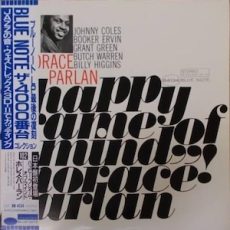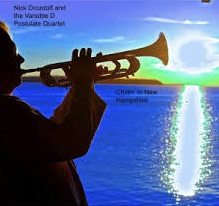
Requisites
Happy Frame of Mind ~ Horace Parlan | By Eddie Carter
Horace Parlan has always been one of my favorite pianists, and this morning’s record from the library is a 1963 recording session that remained shelved until 1976. Happy Frame of Mind (Blue Note BST 84134) is a sextet date that was initially released as a two-record set by Booker Ervin. It finally hit the stores a decade later with its original cover and catalog number. The supporting cast is a stellar one: Johnny Coles on trumpet, Booker Ervin on tenor sax, Grant Green on guitar, Butch Warren on bass, and Billy Higgins on drums. My copy is the 1991 Toshiba EMI Japanese Stereo reissue sharing the original catalog number.
Side One opens with Home Is Africa by Ronnie Boykins. Butch and Billy get things started ahead of the ensemble’s haunting melody. Johnny is up first with a relaxing reading; then Booker gives a gorgeous solo. Grant makes an effective contribution next. Horace gives the song’s most inventive improvisation before the sextet’s closing chorus ends as it begins. A Tune For Richard by Booker Ervin gets busy with Billy’s lively introduction to the ensemble’s brisk melody. Johnny leads the charge, then Booker takes flight next. Grant delivers the third message effectively, and Horace ends with a spirited interpretation preceding the theme’s restatement and close.
Back From The Gig by Horace Parlan is the pianist’s reference to returning home from a particularly difficult gig, and the sextet begins with an easygoing melody. Horace’s opening solo flows with feeling, then Grant builds a perfect melodic line in the following reading. Booker follows with a statement that’s warm and heartfelt, and Butch takes over for a tender finale leading back to the climax. Dexi by Johnny Coles begins Side Two at a brisk clip with a quick melody into Johnny’s opening solo that sets the table. Booker is given considerable space for an impressive statement next. Horace follows with a soulful interpretation, and Grant takes a quick turn, preceding the quick reprise and fadeout.
Kucheza Blues by Randy Weston maintains an upbeat pace with the trio’s introduction to the front line’s jaunty theme. Horace leads the way with a refreshing solo. Booker follows, fueling the second statement with enthusiastic choruses. Johnny sinks his teeth into the third reading, and Butch walks swiftly toward the closing chorus and fade out. Horace’s Happy Frame of Mind is a happy rocker that the sextet has fun in the melody. Grant takes the lead and beautifully executes the first solo. Horace follows with a thoroughly enjoyable reading. Booker improvises freely in the third spot; then Johnny shares the finale with Billy before the sextet returns to take it out.
Alfred Lion produced the initial session, and Rudy Van Gelder was the recording engineer. The reissue’s sound quality is superb, with a vivid soundstage that brings the musicians to your listening room with excellent fidelity. Happy Frame of Mind is an overlooked jewel in Horace Parlan’s discography. If you’re a fan of Horace Parlan and don’t own the two-record set, Back From The Gig, I invite you to seek out Happy Frame of Mind on your next record shopping trip. It’s a wonderful album with a stellar supporting cast that I hope more jazz fans will discover!
~ Back From The Gig (The Blue Note Reissue Series BN-LA488-H2) – Source: Discogs.com © 2024 by Edward Thomas CarterMore Posts: choice,classic,collectible,collector,history,instrumental,jazz,music,piano

Daily Dose Of Jazz…
Christiaan Herbert “Chris” Hinze was born June 30, 1938 in Hilversum, Netherlands. He initially performed publicly as a pianist until the mid-Sixtiess, when he began studying flute at the Royal Conservatory of The Hague and then came to America and Berklee College of Music.
As a pianist, he played with Boy Edgar until 1966, but by 1967 was playing flute professionally with the bassist Dick van der Capellen. His first releases as a leader were issued in 1969, and in 1970, and was awarded the Best Soloist prize at the Montreux Jazz Festival.
The 1970s saw him forming his own ensemble, the Chris Hinze Combination, which included Gerry Brown and John Lee, which produced some success with arrangements of Baroque music in a jazz setting. He founded the record label Keytone Records in the mid-1970s.
In the 1980s, Hinze played for several years in a duo with Sigi Schwab and continued touring with a new version of his Combination. He began studying the music of Tibet and South Asia in the middle of the decade, forming a world music ensemble which shifted toward more new age and electronic music styles rather than jazz.
Flautist Chris Hinze continues to compose and perform.
More Posts: bandleader,flute,history,instrumental,jazz,music

Daily Dose Of Jazz…
Ike Sturm was born June 29, 1978 and was raised in a musical home in Wisconsin, learning from his father, renowned composer and arranger, Fred Sturm. He studied jazz and classical bass and composition while earning undergraduate and graduate degrees at the Eastman School of Music. In addition, he studied privately with legendary bassist Dave Holland.
Sturm went on to serve as Music Director for the Jazz Ministry from 2004-2021, commissioned him to compose Jazz Mass, a work for voices, strings and soloists that merges diverse musical languages into a powerfully unified aesthetic. The piece was released to critical international acclaim, named Best Albums of the Year by Downbeat and has been performed across the U.S., Scandinavia and Europe.He has performed with Gene Bertoncini, Theo Bleckmann, Ingrid Jensen, Donny McCaslin, Bobby McFerrin, Ben Monder, Maria Schneider and Kenny Wheeler. He has played on four Downbeat award-winning recordings, several Steve Reich releases on Canteloupe and Nonesuch Records and performed with Alarm Will Sound and the International Contemporary Ensemble, along with numerous creative ensembles in New York.
Bassist Ike Sturm currently leads a new worshiping community in New York City called Finding Our Way Home. He was commissioned by Montview Presbyterian Church in Denver, Colorado to write a new large-scale piece called River for 100 voices, string orchestra and the Ike Sturm Ensemble.
More Posts: bandleader,bass,history,instrumental,jazz,music

Daily Dose Of Jazz…
Nick Drozdoff was born on June 28, 1953 in Glencoe, Illinois. Holding degrees in music, engineering and physics, in 1978 he began his professional career in Maynard Ferguson’s band. Leaving the band in 1981 he ran his own contracting business and after completing his masters in classical trumpet, he began leading a double life in 1991 when he took on a day gig as a high school physics teacher at Winnetka’s New Trier High School.
After leading a double career existence and garnering awards as a high school science teacher, Nick developed endorsement deals as a jazz trumpeter at night. Retiring from teaching he pursued his musical passion. Now he spends time in Door County, Wisconsin and in the Northern Suburbs of Chicago where he regularly performs in both locations. He lives equal time in both places, depending on his performance and lecture/masterclass schedule.
His latest project centers on his new band, The Variable D Postulate Ensemble. This band is minimally a quartet of drums, guitar, keybaord and trumpet. It is primarily jazz driven but not exclusively. Drozdoff built a studio where he does his recording and has built connections as a trumpeter all over the world.
He has recorded with Grilly Brothers, Marshall Vente, Doug Lofstrom, Chuchito Valdes, and Guy Fricano. He is currently on call as solo trumpet with the Chicago Grandstand Big Band, The Jazz Consortium Big Band and the Starfall Big Band. Trumpeter Nick Drozdoff frequently appears as a classical soloist for churches, recitals andleads one of the Chicago area’s finest brass quintets.
More Posts: bandleader,history,instrumental,jazz,music,trumpet

The Jazz Voyager
From Northern California to Charm City sitting on the Chesapeake Bay for a night of music and then a short hop down to the Eastern Shore for the best crab cakes on the East Coast. The spot this Jazz Voyager will be in, the Keystone Korner Baltimore, is the second iteration of the famous club of the same name that held jazz down in SAn Francisco during the upheaval of music leading to the rise of rock and R&B.
This week the band taking the stage is The Heavy Hitters, a band composed of leader Mike LeDonne on piano, Eric Alexander on tenor saxophone, alto saxophonist Vincent Herring, trumpeter Sean Jones, Alexander Claffy on bass with drummer Kenny Washington. This voyager will be in the audience to savor the ambience and the jazz .
The venue is located at 1350 Lancaster Street, Baltimore, MD 21231. For more information you are invited to visit keystonekornerbaltimore.com.
More Posts: adventure,club,genius,jazz,music,piano,preserving,travel



